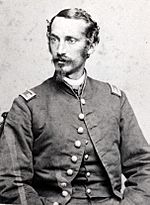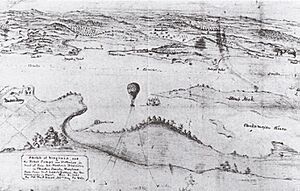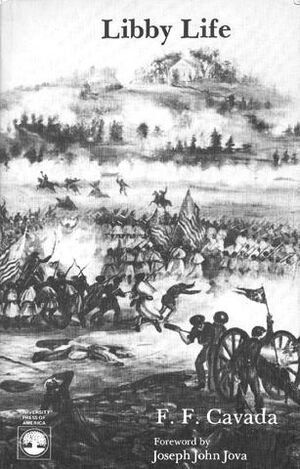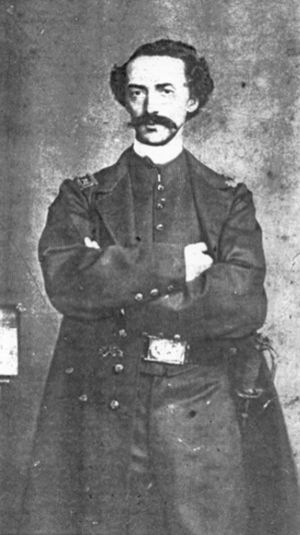Federico Fernández Cavada facts for kids
Quick facts for kids
Federico Fernández-Cavada
|
|
|---|---|

Lt. Colonel Federico Fernández Cavada
|
|
| Nickname(s) | General Candela (General Fire) |
| Born | July 8th, 1831 Cienfuegos, Cuba, Spanish Empire |
| Died | July 1st, 1871 (aged 39) Puerto Príncipe, Cuba, Spanish Empire |
| Allegiance | |
| Service/ |
|
| Rank | Army General (Cuba) |
| Commands held | 114th Pennsylvania Infantry Regiment |
| Battles/wars | American Civil War Ten Years' War |
| Other work | engineer, author |
Federico Fernández-Cavada (born July 8, 1831 – died July 1, 1871) was an important leader during the American Civil War in the United States. He also became a top commander in Cuba's fight for independence.
Because he was a talented artist, he joined the Hot Air Balloon Unit of the Union Army. From a hot air balloon, he drew maps of enemy positions. He even sketched enemy movements from a balloon called Constitution in 1862.
During the Battle of Gettysburg, he was captured and sent to a prison for Union officers. After being released, he wrote a book about the harsh treatment he received. His brother, Adolfo Fernández Cavada, also served as an officer in the Union Army.
After the American Civil War, Fernández-Cavada became a diplomat for the United States in Cuba. When Cubans began fighting for freedom from Spain, he joined them. He rose to become the commander-in-chief of all Cuban forces during the Ten Years' War.
Contents
Early Life and Education
Federico Fernández-Cavada was born in Cienfuegos, Cuba. His mother, Emily Howard Gatier, was an American citizen from Philadelphia. His father was Isidoro Fernández Cavada.
After his father passed away in 1838, his mother moved back to Philadelphia with her three sons. There, she married Samuel Dutton. Federico went to Central High School in Philadelphia. Later, he became a civil engineer and worked on the Panama Canal.
Serving in the American Civil War
When the American Civil War started, Federico and his brother Adolfo joined the Union Army. They first served in the 23rd Pennsylvania Infantry Regiment. Federico later moved to the 114th Pennsylvania Infantry Regiment.
His regiment was part of the Army of the Potomac. They fought in major battles like the Second Battle of Bull Run, the Battle of Fredericksburg, and the Battle of Gettysburg.
Sketches from the Sky
Federico Fernández-Cavada was known for his artistic skills. Because of this, he was assigned to the Union Army's Hot Air Balloon unit. His job was to sketch enemy positions and movements from high above.
On April 19, 1862, he drew detailed maps from a balloon during the Peninsula Campaign in Virginia. These sketches helped the Union Army understand where the enemy was.
Captured at Gettysburg
On August 29, 1862, Federico was promoted to lieutenant colonel. During the Battle of Gettysburg, his regiment faced tough fighting. On July 2, 1863, the 114th Pennsylvania fought against Confederate troops at the Peach Orchard.
Colonel Fernández-Cavada was captured during this battle. He was sent to Libby Prison in Richmond, Virginia. This prison was known for its harsh conditions. He was released in 1864 as part of a prisoner exchange. After his release, he returned to his unit and served until April 1865.
Life as a Prisoner of War
After his release, Fernández-Cavada published a book called LIBBY LIFE: Experiences of A Prisoner of War in Richmond, Virginia, 1863-64. The book came out in 1865. In it, he described the cruel treatment he and other prisoners faced in the Confederate prison. The book also included his own drawings of the prison and daily life there.
Leading the Fight in Cuba
After the American Civil War, Fernández-Cavada became the United States consul in Trinidad, Cuba. There, he met General Thomas Jordan, a former Confederate general who was helping the Cuban rebels.
This friendship inspired Fernández-Cavada to join the Cuban fight for independence from Spain. This conflict became known as Cuba's Ten Years' War (1868–1878). His brother Adolfo also resigned from his consul position and joined the rebels.
Federico was named a General for the District of Trinidad. He became known as "General Candela" (General Fire). This nickname came from his battle tactic of burning and destroying Spanish property. On April 4, 1870, he was named commander-in-chief of all Cuban forces.
He also wrote an article about the beautiful Caves of Bellamar, near Matanzas, Cuba. This article was published in Harper's New Monthly Magazine in November 1870.
Death
Federico's oldest brother, Emilio, stayed in Philadelphia. He raised money and sent weapons to the Cuban rebels. In 1871, Federico Fernández-Cavada took charge of a military division in Camagüey. He planned an invasion on the western coast of Cuba.
He was going to travel to the United States to get more support for Cuban independence. However, he was captured by a Spanish gunboat called Neptuno. He was taken to Puerto Principe and then to Nuevitas.
Spanish authorities tried him and sentenced him to death by firing squad. Generals George Gordon Meade, Daniel Sickles, and Ulysses S. Grant from the U.S. Army tried to get him released, but they failed. Fernández-Cavada was executed on July 1, 1871. His last words were "Adios Cuba, para siempre" (Goodbye Cuba, forever).
Legacy
- A monument was built on February 24, 1929, in Nuevitas, Camagüey Province. It honors those who fought in the Ten Years' War and were executed by the Spanish. Federico Fernández-Cavada is among those honored.
- The Province of Cienfuegos also remembers him. A modern medical clinic in Cienfuegos, called "Policlínico-Facultad "Federico Fernández Cavada," is named after him.
Awards and Decorations
Fernández-Cavada received the following awards:
See also
 In Spanish: Federico Fernández Cavada para niños
In Spanish: Federico Fernández Cavada para niños
- Hispanics in the American Civil War
- Adolfo Fernández Cavada





